St Peter's, Holy Trinity and All Saints
(All Saints was also referred to as 'Alhalens' or 'All Hallows').
They are of very ancient foundation being as old as the introduction of Christianity in the Kingdom of the West Saxons in the 7th Century. Further more detailed background is freely available from the book 'The History of Dorchester' by James Savage which was published in 1837. A full transcription can be viewed at google books and I have used extracts in the short accounts given about these churches below [See St Peters on pages 161-180; Trinity 181-195 and All Saints 196-200: Note:- There are several blank pages at the start before 2 separate indexes - a large file which may be easier to download to read]. Most of this text has also been used in John Hutchins 'The History and Antiquities of the County of Dorset' his 3rd Edition published 1868. see pages 377-
St Peter's
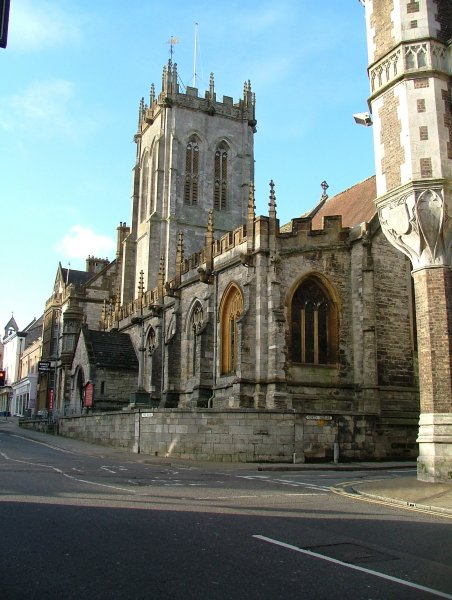
The parish of St Peter's was a distinct and independant parish with its own parochial officers, responsible for maintaining its own poor, and raising funds to repair the church. Situated in the middle part of town at the higher end of the Corn Market the present building dates back to 1454 and consists of a chancel, nave and two ailes of equal extent with the nave and chancel. The north aile was rebuilt by some of the family of 'WILLIAMS' of Herringstone whose burial place is there. The south aile is embattled and its east end raised. The east ends of both ailes were probably chapels or chantries. The body is compass-roofed supported by five pillars but has no windows over the arches. The tower is very neat adorned with pinnacles and battlements and is 90 feet high. There were formerly five bells which in 1734 were re-cast and augmented to eight, chiefly at the expense of the representatives of the borough.
Though it is the largest and the principal church in the town, it is only a chapel to the Holy Trinity, and has been since 1303, and perhaps before; yet there are two instances in the Sarum Registers when the king presented this as a distinct rectory. From the municipal records of Dorchester in 1657 and a legal case that arose in 1826 it is clear that the two churches were united and this for example was why the Rev. John White was appointed by the King to Holy Trinity in 1606 but often preached from the pulpit and, was eventually buried in the south porch of, St Peters church in 1648. Two of the most prestigious monuments in the church are:-
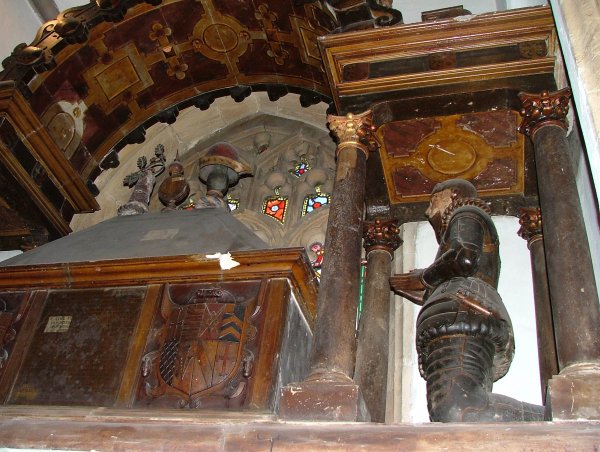
Monument to Sir John WILLIAMS
On the north side of the chancel is a very handsome monument of grey marble for Sir John WILLIAMS of Herringstone, knight. which almost fills up an arch of the church. In the centre is a compartment containing the inscription. At the east end under a canopy of four pillars, the statue of Sir John in armour, bareheaded and kneeling dated 1628. At the west end, under a like canopy, that of his lady in the same posture. From the canopies springs a large arch having eleven escutchens on each side containing the arms of the Williams's, Uvedales and other families that intermarried with them. The whole is adorned with painting, gilding and carved work. An inscription in gold Roman capitals on a black background;-
Here underneath rest the bodies of Sir John WILLIAMS late of Herringstone knight and the Lady Eleanor his wife daughter of Henry UVEDALEof Moore Critchel in the county of Dorset Esq who having lived together as man and wife for fifty years in which time they had issue seven sons and four daughters were in the year of our Lord 1617 divided in death. For in that year the 7th September died this knight to the general grief of all good men. aged 72 years. His Lady left alone lived alone, till she was again joined with her husband in this place on the 14th April in the year of our Lord God 1625 aged 80 years. which though it were a long life yet was it so good and virtuous that she lived and died beloved of all. She in her lifetime by her will appointed this monument in memory of her dear husband herself and her ancestors who were builders of this isle to be erected care of George WILLIAMS her third son living and sole executor which was accordingly performed and finished Anno Domini 1628.
In 1549 John WILLIAMS of Herringstone esq by his will dated May 29 proved Feb 3 in the same year appointed his body to be buried in this church as did Robert WILLIAMS of the same esq by will dated 1566 and proved 1569.
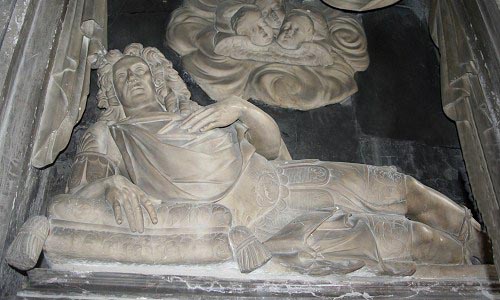
Monument to Denzil Lord HOLLES
On the south side of the chancel opposite the monument of Sir John WILLIAMS is a very lofty and superb one for for the Lord Denzil HOLLES of white marble supported by pillars of varigated marble railed with iron and filling up the arch between the chancel and south aile. On the top between two urns is an escutcheon containing the arms of HOLLES the Duke of Newcastle. In a compartment on the base
" To eternize the name and honour of Denzil Lord HOLLES baron of Ifield. His birth was equal to his virtues being the second son of John the First Earl of Clare; who by sea and land, at home and abroad, did not more signalise
himself in the service of his country, than he
was meritoriously distinguished and rewarded
by Queen Elizabeth and King James. All that
Denzel's wit or courage, probity or industry,
presaged in his youth, he made good and exceeded when grown a man. For as his excellent endowments and abilities made him early
known to his prince and country, so he could,
by his eloquence and valour, intrepidly defend
the liberties of the latter, without refusing the
obedience that was due to the former. When
the rights of the nation were barbarously invaded, by that army which the Parliament levied to secure them, he bore the violence and
injustice of his enemies as it became a finished
hero; nor could losses, exile, or his hatred to
the factious, make him forget the love he owed
to England. After the restoration of the monarchy, he was created Baron Ifield, by King
Charles the Second, and had the honour of representing him in two extraordinary embassies;
the one to Louis, king of France, who no less
admired the generosity whereby he maintained so
high a character, than be dreaded a virtue he was
not able to corrupt by his magnificent presents,
which were more princely refused than offered.
No part of his reputation was diminished when
he went afterward as plenipotentiary to the treaty
at Breda. His learning was unaffected, useful,
and general; but not to be exceeded by any in
the knowledge of the ancient records of the
kingdom, and tee distinct powers of the several
parts of the administration. So true a friend,
In a vault near this lies the Sir Francis ASHLEY Knight. In another his sole heiress and daughter, wife of Lord HOLLES, and one of their children.
In the fourth window by the North aisle lies on a stone coffin, the effigy of a knight cross-legged, completely armed in a coat of mail and helmet, which covers the greater part of the face. He has a belt, sword, spurs and shield, but without armorial bearings. His head rests upon a cushion his feet on a lion or dog. If this represents a crusader who either vowed or actually made a expedition to the Holy Land it must be ancient. The first crusade was published by Pope Urban II at the Council of Clermont in Auvergne in the year 1095 and the Holy War ended in 1291. There is a similar figure in the South window as depicted below.
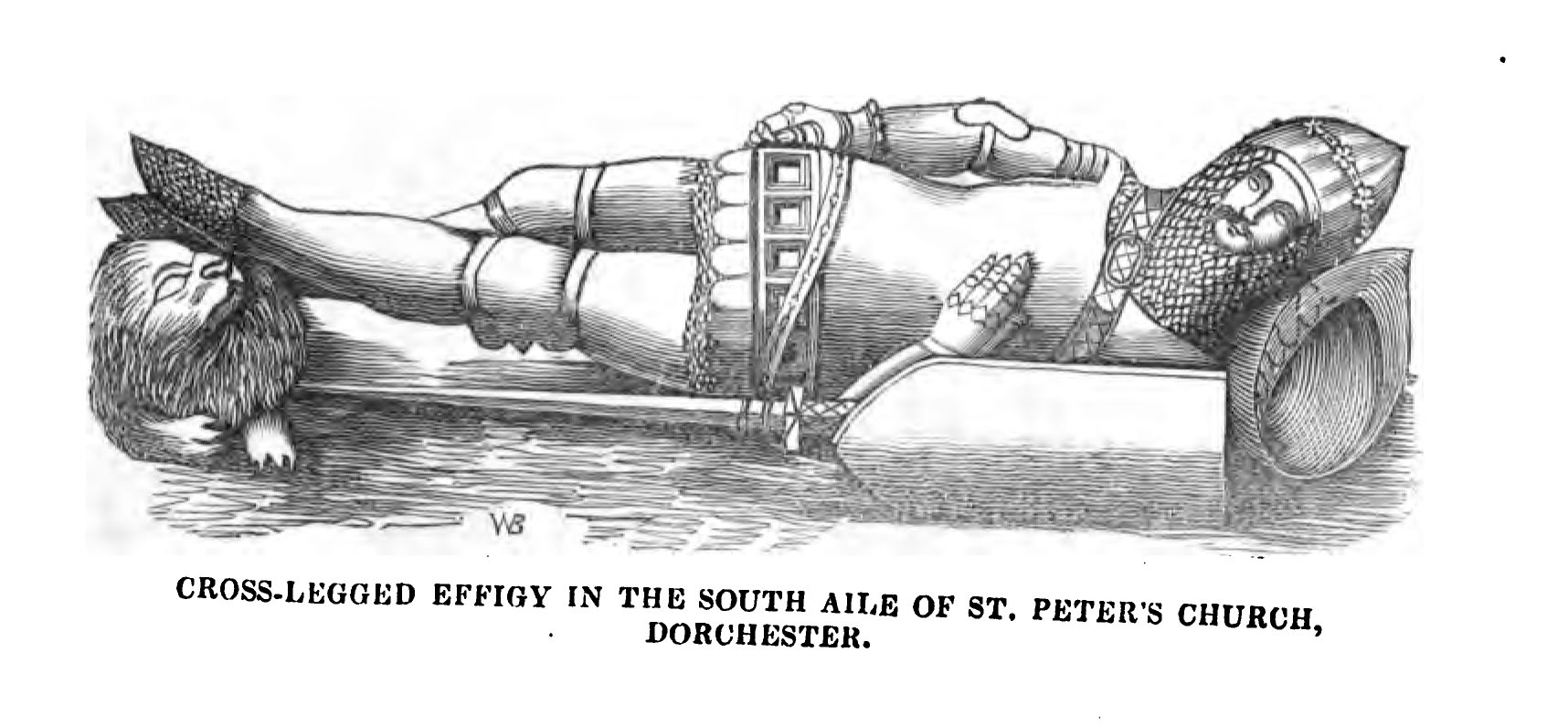
These effigys are said to represent two crusaders from the 'CHIDIOCK Family' founders of the neighbouring priory, and to have been moved to St Peters when the priory church was demolished.
Holy Trinity
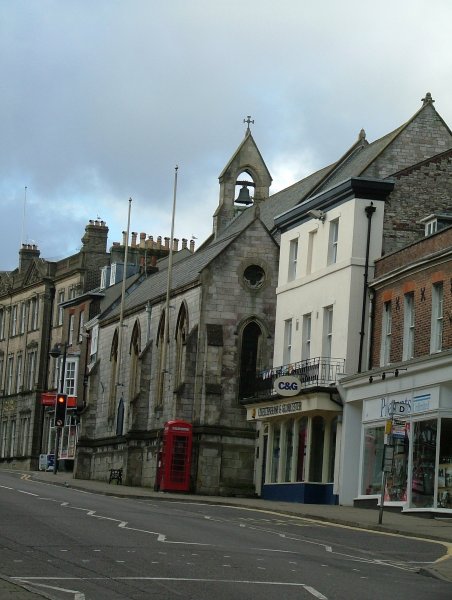
Holy Trinity Church - Dorchester
The old church of Holy Trinity was taken down and rebuilt in 1824. It was an oblong structure but neither large nor ancient; it consisted of a nave, supported by five arches on each side and an aile to the south of equal length and height. The chancel occupied the middle of the nave and aile and was divided from the latter by rails. The tower was low and probably had not been raised after the fire of 1613 in which the former church was thought to have been consumed. It contained five bells and was adorned with battlements and pinnacles. The South aile was built after the union with Frome Whitfield the parishioners then being too numerous for the church. The whole church was neatly pewed and adorned with a handsome pulpit and gallery.
The present structure was completed in 1824. It is a very neat oblong building with the entrance at the West end which opens into a small vestible. It is very neatly pewed with the reading desk on one side of the communion table and the pulpit on the other. There is a spacious gallery on either side, and an organ at the West end. On each side of the entrance there is an octangualar turret, the southern one containing a clock. The East window is of painted glass, very hansomely executed and below this and above the communion table there is a portrait of our Blessed saviour.
In the 20th year of the reign of King Richard II (i.e. 1397) a grant was obtained to found a fratenity dedicated to the Blessed Virgin , in this church. In the 1st year of the reign of King Henry IV (1399) a Chantry (or endowment) of the Blessed Virgin Mary (or B.V.M) was founded by John SYWARD. The Sarum registers are said to contain a list of nine chaplains or wardens of this chantry covering the period 1403 to 1541. In the 2nd year of the reign of Edward IV (1547/8) the King in consideration of a payment of £149.11.9d granted to the burgesses of Dorchester and their successors a messuage and lands and twenty two other messuages, burgages (i.e. tenure of land held in return for service or annual rent) and gardens belonging to this chantry amounting to a yearly value of £6.9s.3d. In the eleventh year of the reign of Elizabeth I (1568) five tenements and eleven acres of land in Dorchester belonging to the chaplain in this church and in the occupation of the bailiffs were granted for 21 years to John HERBERT. The parish of Frome Whitfield was annexed to that of Holy Trinity by Act of Parliament in the 7th year of the reign of James I [1610] .
The register of this church begins in 1559 and within it is inserted a memorandum :-
"1651 - August 22nd, at night there was great thunder and lightening, such as has not been known by any living in this age, and there fell with a great storm of hail, some of the stones of which were seven inches about, with abundance of rain, and it continued all night and great part of next morning, till eight or nine of the clock. That same day were Mr LOVE and Mr GIBBONS beheaded".
[Note:- The Rev Christopher LOVE MA was arrested by Oliver Cromwell's forces for his alleged involvement with a plan to raise money for the restoration of the monarchy, a charge Love denied and held in the Tower of London. Both he and John GIBBONS who was a condemned prisoner at Newgate had their appeals rejected by parliament being mentioned in the House of commons Journal. They were both executed on 22 August 1651].
On the south wall near the east end was a mural monument of white marble:- "To the pious memory of Dorothy TURNER, widow late of this town. She died 9 Nov 1718, aged in years but much more in piety and virtue. Near this place also lies the body of Katherine ROSE widow of Thomas ROSE late of this town MD. They were the only surviving sisters and co-heirs of John HURDING on Longbredy in this county Esq. by whose death that ancient and religious family was extinct".
At the south side of the church near the door, on a tablet in gold letters:- "To the memory of Mr Edward DASHWOOD of this parish who by his last will gave to the poor of the parish within this borough of which he was thrice Mayor fifty pounds; the profit thereof to be annually and equally divided between them the 9th of March for ever. And also to the poor of West Stafford, ten pounds to be distributed amongst them the same day". He died 5 Feb 1666 at the age of 78.
There is also an elegant white marble tablet to the memory of Dr William CUMING who practiced medicine in this town for forty-nine years and greatly assisted the Rev. J HUTCHINS in his elaborate history of Dorset
All Saints
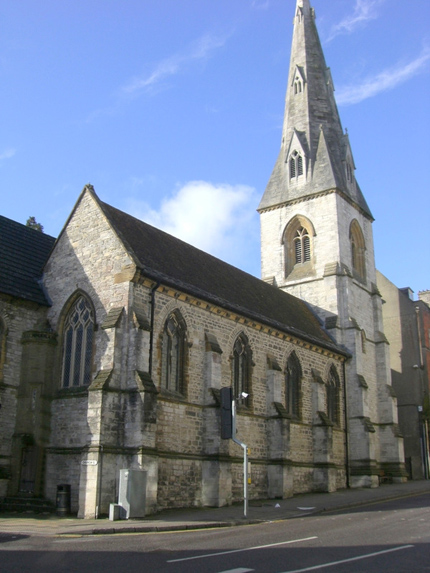
All Saints Church - Dorchester
The Parish of 'All Saints' commonly called 'All Hallows' or the lower parish, occupies the eastern part of the town and contains all of East Street, from the church on one side and the Kings Arms Inn on the other, inclusive to the end of town. Durn [Dorn] lane which runs parallel with East street; Church Lane, Gaol Lane, at the corner of which the gaol stood, part of Priory lane; Gallows Hill lane, at the south end of which the gallows were formerly placed; and The Walls, a lane near the end of Durn [Dorn] Lane.
The church situated at the West end of the parish is a large but does not seem to be an ancient building, consisting of a nave, supported by eight pillars, and a North aisle of equal length and height. The tower is low and thought to have been raised since the fire of 1613 in which the church was probably consumed. In the tower are three bells. It was repaired an beutified in 1720 at the expense of Robert BROWNE of Frampton Esq. On a carved wooden screen is the date 1630.
Note:- There is an entry in William Whiteway's diary for 3rd January 1626/27 which states " This winter, the Church of All Saints in Dorchester, was enlarged" .